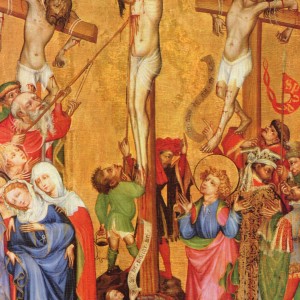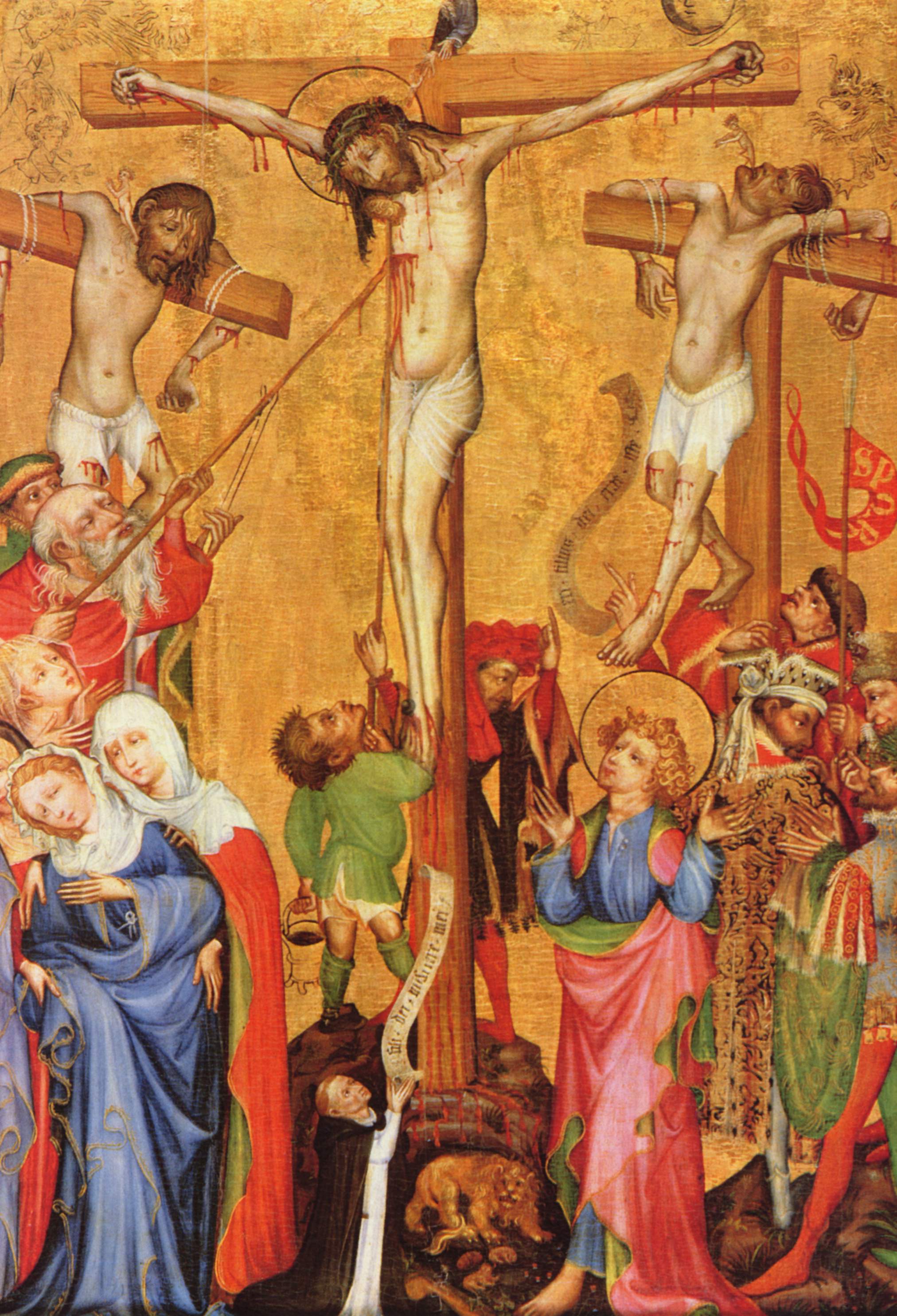Yesterday was the second of the three-part “Shameless Popery” live apologetics series. It was entitled “The Priesthood of Christ & Adam and Eve, Jesus and Mary.” The second of those two topics, on the parallels between Adam and Eve with Jesus and Mary, is something that’s been covered before on this blog, but I wanted to share a few new things. First, this helpful chart that we prepared for the talk:
Adam & Eve
|
Jesus & Mary
|
“In the Beginning”
(Genesis 1:1)
|
“In the Beginning”
(John 1:1)
|
Seven Days
(Genesis 1:1-2:3)
|
Seven Days
(John 1:29-2:1)
|
Two sinless virgins
(Genesis 2:25; Genesis 4:1)
|
Two sinless Virgins
(Isaiah 7:14; Luke 1:34; Hebrews 4:15)
|
Man is called “Adam”
(Genesis 2:20)
|
Man is called “the New Adam”
(1 Corinthians 15:45)
|
Woman called “Woman”
(Genesis 2:23)
|
Woman called “Woman”
(John 2:4; John 19:25-27)
|
Woman formed from Man
(Genesis 2:22-23)
|
Man formed from Woman
(Luke 1:34-35)
|
Woman Tempted by Fallen Angel
(Genesis 3:1)
|
Woman Greeted by angel
(Luke 1:26-28)
|
Garden of Eden
(Genesis 2:8)
|
(Matthew 26:46)
|
Tree of Knowledge of Good & Evil
(Genesis 2:8)
|
The “Tree” of the Cross
(Galatians 3:13)
|
Sinful Fruit of the Tree
(Genesis 3:6)
|
Sinless Fruit of Mary’s Woman
(Luke 1:42)
|
War Between Serpent & Woman
(Genesis 3:15)
|
War Between Serpent & Woman
(Revelation 12:1-5, 15-17)
|
Renaming from “Woman” to “Mother of the Living”
(Genesis 3:20)
|
Renaming from “Woman” to “Mother”
(John 19:25-27)
|
Second, the accompanying packet talked about how Adam and Eve prefigure both the relationship between Jesus and Mary, and the relationship between Jesus and the Church:
Hermann Schadeberg (?),
Crucifixion with a Dominican friar (1415)Now, with that in mind, we sometimes see Mary and the Church fulfill this Genesis imagery in unique ways. For example, there are only two people ever described in Scripture as having a single parent; Eve, whose body is taken completely from Adam, while he slumbered (Gen. 2:22-23); and Jesus, who takes on Flesh through the Virgin Mary (Luke 1:34-35). So there, we see a very neat parallel between Adam & Eve and Jesus & Mary.
But this passage is fulfilled in a different way for Jesus & the Church. As mentioned earlier, after His Death on the Cross, a soldier lances Jesus’ side, and Blood and water flow out (John 19:34), which the Church Fathers saw as representing Baptism and the Eucharist. It’s through these Sacraments that Christ forms His Church. That is, while Jesus is “sleeping” in Death, His Bride comes forth from His Side, through the saving waters and life-giving Blood. There’s no need to choose one or the other: both of these events are prophetic fulfillments of Genesis 2:22-23.This is all part of a much larger picture painted in Scripture of Jesus bringing about a New Genesis through His Death and Resurrection. But to get the full picture, you need to understand the role played by the New Eve, which means understanding the role of Mary, icon of the Church.
Enjoy!


I don’t really understand where you are going with this – or coming from. I’d say that every Catholic I know understands all these things . . . .?
I’m with Joe, what diocese are you in?
Kim,
That’s great news! Out of curiousity, what diocese are you in?
I haven’t found that this is something that all Catholics know (nor is it something that any of the Protestants I’ve spoken to have even heard of). I personally didn’t know about the bottom parallel until December of last year – about how the name change from Woman to Eve at the moment of the Curse (Gen. 3:20) Christ’s transition from calling Mary Woman to Mother at the moment of the Crucifixion (John 19:25-27).
I.X.,
Joe
“Sinless Fruit of Mary’s Woman” (Um?)
I am a new catholic and i did not know this – many thanks for this enlightenment
@Ron
I think he meant “Sinless Fruit of Mary’s WOMB.”
@Joe
If you update the chart for future use, I would suggest fixing the womb/woman thing and changing the row labeled “Two Sinless Virgins” to “Sinless Virgin becomes a Mother.” The plural made me wonder who the second sinless virgin in Genesis (and then in the Gospels) was, making for a total of four, since elsewhere in your chart you only refer to either Eve or Mary (either Adam or Jesus) at one time.
Also, may I suggest that the real parallel is SIX days rather than seven? In order to get to seven days in John, you have to interpret 2:1 as adding three days to the four counted out in Chapter 1, but by the usual Biblical logic (counting Easter Sunday as the “third day” from Good Friday), the phrase “on the third day” should only add two more days, making for a total of six, the sixth day being the third day from the fourth day. Which would put the Wedding at Cana on the sixth day, which would line up perfectly with the creation of man and woman (and marriage) on the sixth day according to Genesis 1:27-31. John stops counting with the Wedding at Cana, so there is no seventh day to parallel the Sabbath rest in Genesis . . . maybe because Jesus isn’t actually resting from his (re)creative work in the Gospel? (Holy Saturday would be his first real day of rest and could, I suppose, be counted as the seventh day, which would work because it would make Easter Sunday the eighth day . . .) Just a thought.
Finally, any chance we can get copies of these handouts from your apologetics series?
I would like to make some further comments about Mary in addition to the very interesting ones you have indicated already. The topic is vast, so I can only give an outline here. As I am sure many people already know, in the Gospel of John, both at Cana (Jn 2:4) and again at the cross, Jesus addresses his mother with the title “woman” (Jn 19:26). Although he uses this term also with other women in normal circumstances, it was not normal for anyone to address his own mother with this term. The answer as to why Jesus said this is very similar to Jesus changing the name of Simon to Kephas (rock). It indicated a role that Kephas was going to have in the Church (Mt 16:18) that Jesus was creating. In the case of Mary, Jesus is not giving her a new title, he is recognizing a role that she already had when God created her. The idea that Mary is a parallel, but victorious opposite, of Eve is an idea that we find written already in second century Christianity. I say “written” because there were many truths of faith that were not written, as St. Paul tells us (2 Thess 2:15); nevertheless, this idea finally was written down by St. Justin (who dies in 165) and Iranaeus (who dies in 202). As these men worked in both in the west and east, we can say the idea was universally accepted (we do not find contemporaries rejecting this position). Just as Adam (Gn 2:23) recognized in the first woman his helpmate (and called her “woman”), Jesus, the new Adam, recognizes in Mary his helpmate and calls her “woman,” and at her request, Jesus gives the sign (wine from water) of the new creation: Jn 2:11. The new creation, merited by the obedience of Jesus the God-man, was already being formed throughout salvation history and comes to a climax in Mary’s yes to the will of the Father, but it was prepared for by the very fact that she, like the first “woman,” was created by God immaculate due to the merits of Christ crucified who dominates human history from the very beginning as the omnipresent son of God. Since sin is the cause of death in Genesis, Mary, the new Woman, is exempt from the corruption of death as the new “woman” created perfect and without stain (immaculate) by God who does all things well. The words of the psalmist which St. Peter applies to Jesus “you will not allow your just one to experience decay” (Acts 2:25) also apply to Mary. This is where we find another biblical seed of the doctrine of the Assumption. That is why, as a parallel to Eve, Mary is called “woman” in John’s Apocalypse as well. As the new creation, we see her with the cosmic signs of the original creation (sun, moon, stars). However, her travail at the “birth” clearly does not regard the physical birth of Jesus (since he is immediately saved from Satan the murderer), rather it regards his rebirth from death (his, so to speak, “baptism”) and immediate entrance into the presence of God the Father as the victorious obedient son of a mother who shares in his struggle and victory (as was predicted by Simeon, e.g. Lk 2:35). I would add a thought here. The term “New Eve” is often used to indicate Mary’s parallel role as mother of those reborn in Christ (Rev 12:17). However, the title which the Bible specifically gives her as the new “woman” shows better her immaculate origin and her assumption (Rev 12:14) in which she is saved both spiritually and physically from the powers of Satan, the adversary predicted in Genesis. In fact, it is after the sin of the first woman that Adam gives his wife a new name “Eve”(Gn 3:20) since her role has been limited after sin. No longer was Eve immaculate and exempt from death, though her limited role as mother continued. Mary has all the fullness of womanhood as she passed the test as the helpmate of her divine Son who preserved her always by his grace from the bonds of Satan which would have trapped her too, were she not saved by the Savior’s grace from Satan’s touch. Moreover, the role of Mary as Woman includes her role as universal mother just as Jesus as the new Adam is also the origin (Father) of the new creation.
In Gn 2:24, it states, “Therefore shall a man leave his father and his mother, and shall cleave to his wife; and they shall become one flesh.”
What bearing does Gn 29:34 have on Gn 2:24; as well as how it could tie in with Eph 5:22-32.
Also, what is the significance of the number three being used in Gn 29:34 and Gn 46:11. Levi is the third son, yet also begets three children. Also, it must be recalled that when Scripture states that Adam begot Seth in his own image/likeness, that Seth is the third child. Is there a literary connection between Gn 1:26; 2:24; 5:3; and 29:34?
The use of the plural in Gn 1:26, as well as the triune emphasis in later passages, seems to lend support to the Trinitarian interpretation of the imago Dei.